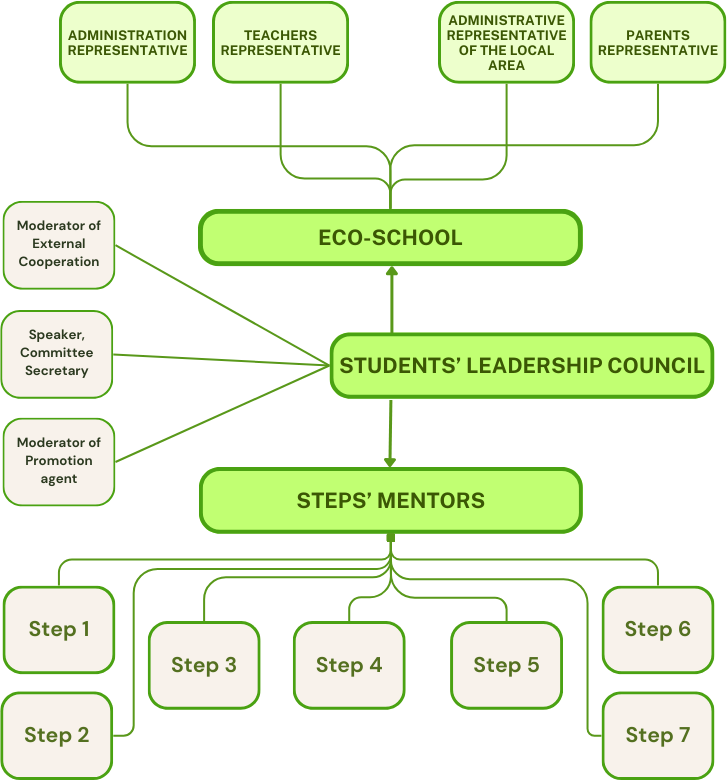SEVEN STEPS METHODOLOGY
The Seven Step process is the basic framework that guides an Eco-School to plan and implement the learning journey. The steps are intended to be flexible enough to accommodate any school context, and environmental themes are the ‘means’ to bring about change through active involvement of children through a rigorous pedagogical process.

Advantages of the methodology for Schools and Students:
School
- an improved school environmental impact
- involvement with the local community, other schools and organisations
- financial savings
- international connections
- the embedding of sustainable development principles into the curriculum
- the capacity to nurture and support intrinsic values (care, empathy, creativity, compassion)
- improved wellbeing of children and staf
- a sense of pride in the school among staff and students.
Students
- creating leaders of change in their communities
- empowering future decision-makers
- helping them develop responsible attitudes and commitment
- widening their learning beyond the classroom
- increasing their levels of confidence and motivation
- increasing their participation in environmental actions
- improving their skills and knowledge in all subject areas, including teamwork
- improving their mental and physical wellbeing.

Step ONE:
FORM AN ECO COMMITTEE
The first step of the Eco-Schools programme involves establishing a viable Eco Committee within the organisational structure of the institution. The Committee aims to direct and address all phases of the Eco-Schools programme. It is the driving force of the programme and ensures that students are at the centre of the process as other steps are carried out.

Step TWO:
CARRY OUT A SUSTAINABILITY AUDIT
A Sustainability Audit checklist includes all aspects of the school’s impact on the environment and society in relation to the Main and Crosscutting Eco-Schools Themes.
Problem identification is an important skill. The aim of the Sustainability Audit is to identify the status of sustainability in the school and to call for skills to prioritise. The results of the audit are used to derive the Action Plan.

Step THREE:
LINK TO THE CURRICULUM
The EcoSchools programme is most effective when it is integrated and linked to the school’s curriculum and syllabus, wherever possible.
The role of education is to prepare young people for the expectations of society. Addressing the sustainability challenge is one of the most important issues of our time.

Step FOUR:
THE ACTION PLAN
Identifies and lists specific goals for the reduction of impacts as identified in the Sustainability Audit.
This is one of the most significant steps to develop active citizenship amongst students and help plan their activities. Developing action plans is an important transferrable skill that is required at both the personal and professional level. It also helps in developing the skill of anticipation and mapping scenarios by projecting the consequences and potential impact of different decisions.

Step FIVE:
IMPLEMENTATION, MONITORING & EVALUATION
This is carried out by the Eco Committee to ensure that progress towards targets is checked, amendments are made where necessary, and success is celebrated.
Implementation, Monitoring and Evaluation is action research. As an exercise to assess progress made towards achieving targets identified in the Action Plan and to identify areas that require further corrective action, students learn to work together with dedication and determination. Effective problem solving requires the ability to investigate and evaluate against a set of agreed criteria.

Step SIX:
INFORM & INVOLVE
The aim of the Informing and Involving step is to spread the Eco Committee’s message throughout the school and the wider community through ongoing publicity. It is training to communicate using various tools and to celebrate success. The students learn to share and acknowledge the contributions of different actors – big and small for the future. They learn important skills of public speaking, influencing large community actions, etc. It is a collaborative platform where students, teachers, parents and communities work together to help students progress towards their shared goals of collective well being.

